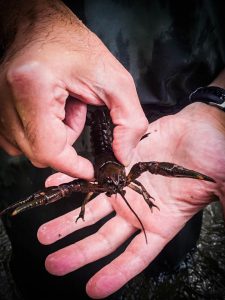
by Derek Springston | May 22, 2019 | Aquatic, Bat Services, Mussel Surveys, News, Permitting, Stream & Wetland Permitting
AllStar Ecology is excited to announce the addition of four new staff members with a wide range of biological and environmental experience and expertise.
Matthew Gilkay, Environmental Scientist I / Aquatic Biologist, is assisting AllStar with freshwater mussel surveys, flow monitoring, macroinvertebrate field and laboratory work, and water quality sampling. Matt obtained his B.S. in Fisheries, Wildlife, and Conservation Biology with minors in Environmental Science, Sustainability Studies, and Marine Biology in 2018. Mr. Gilkay also brings six years of open-water SCUBA diving experience in the Upper Midwest to AllStar’s dive team.
Grant Maltba, Environmental Scientist II / Bat Biologist, has joined our Bat Services team bringing eight years of experience in environmental services. Grant has a Federal Recovery Permit and West Virginia Scientific Collecting Permit for Indiana, gray, and northern long-eared bats. In 2013, he obtained his B.S. in Environmental Studies. Mr. Maltba is assisting AllStar with bat mist netting and acoustic surveys, bat box construction and installation, permitting and report writing, and bat habitat research.
Matt Safford, Environmental Scientist I / Bat Biologist, has also joined AllStar’s Bat Services team with five years of experience in wildlife and ecological monitoring and research. Matt obtained his B.A. in Ecology in 2013 and his M.S. in Entomology in 2018 studying the interactions between bats and their insect prey. Mr. Safford has a West Virginia Scientific Collecting Permit for bats and is assisting AllStar with bat box construction and installation, mist netting and acoustic bat monitoring, report writing, and bat habitat research.
Jason Clingerman, Environmental Scientist II, has joined our Stream and Wetland Delineation team. Mr. Clingerman has 8 years of experience in environmental consulting, and 12 years of experience utilizing GIS for various natural resource applications. He obtained his B.S. and M.S. in Wildlife and Fisheries Resources in 2005 and 2008, respectively. He is assisting AllStar with stream and wetland delineations, permitting, and report writing.
Please join us in welcoming these four great additions to the AllStar Team!
To read more about AllStar Ecology, visit our About Us page.
TALK WITH US
Thanks for reading!

by ALLSTAR | Mar 11, 2019 | Aquatic, News
In 2016, two species of Appalachian crayfish, the Big Sandy Crayfish (Cambarus callainus) and the Guyandotte River Crayfish (C. veteranus) were awarded federal protection under the Endangered Species Act. Due to their limited range and degrading habitat, the Big Sandy Crayfish was designated as a threatened species and the Guyandotte River Crayfish was designated as an endangered species. These designations provide each species protections through United States Fish and Wildlife Service (USFWS) management and oversight of activities which may alter species distribution and/or habitat.
The Big Sandy Crayfish (C. callainus) was first observed in 1937 and is only known from the Big Sandy River watershed in eastern Kentucky, southwestern Virginia, and southern West Virginia. More specifically, it is only found in McDowell and Mingo Counties within West Virginia. The Big Sandy Crayfish is currently considered threatened because of its potential to become endangered if populations continue to decline in number and habitats continue to become limited.

Cambarus callainus
The Guyandotte River Crayfish (C. veteranus) is currently only known to occur in two streams of its historic range in Wyoming County, West Virginia. The species has a well-known population in Pinnacle Creek and a recently found population in Clear Fork. The Guyandotte River Crayfish is considered to be endangered because known populations are small and are isolated from each other. This makes the species vulnerable to die-offs as result of single pollution events and lack of genetic diversity.

Cambarus veteranus
Both species are habitat specialists, meaning they have specific habitat requirements for the establishment and success of their populations. Large slab boulders within swift moving creeks and streams are the preferred refugia for both species. Unfortunately, these habitats can become increasingly scarce as a result of increased sediments to streams such as sand and silt. In addition, historic industrial activities and poor infrastructure in the region have also resulted in water quality issues throughout each species’ historic range.
With habitat availability declining, these two-protected species are forced to compete with common native crayfish species for resources and refugia. Interspecies competition can further inhibit the likelihood of their success.
Crayfish Presence/Absence Surveys
AllStar Ecology has a team of aquatic biologists who conduct threatened and endangered crayfish surveys in the southern coalfields of West Virginia, Virginia, and beyond. With multiple staff members having passed identification and survey protocol testing, AllStar Ecology can deploy teams of aquatic biologists to conduct the necessary surveys.
Over the past two years, our biologists have conducted numerous presence/absence surveys in McDowell, Logan, and Wyoming Counties, West Virginia for bridge enhancement projects and utility lines. Due to the instream work associated with these projects, the surveys were necessary to avoid potential disturbance to endangered crayfish and their habitats.
Having previously worked with federal and state agencies on threatened and endangered crayfish surveys, AllStar has the experience and knowledge to develop survey plans and conduct the necessary surveys to fulfill the needs of your project. Learn more about all of our services by clicking here or contact us for more information.






